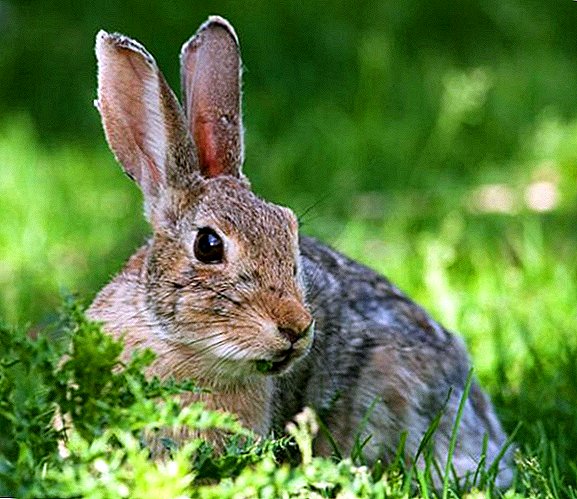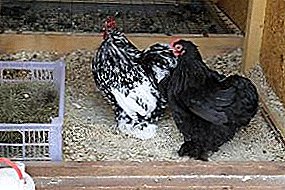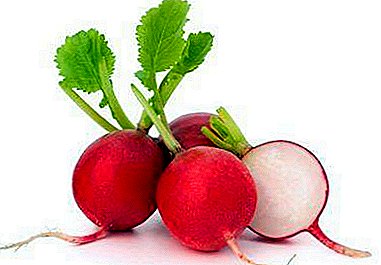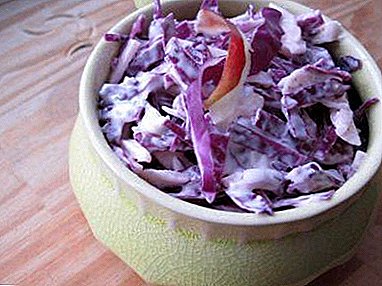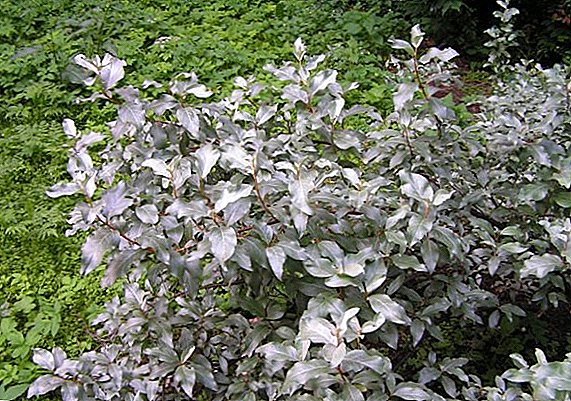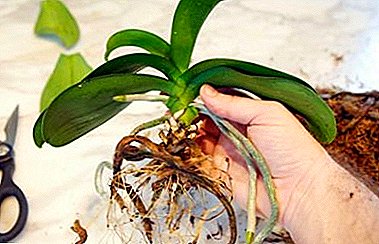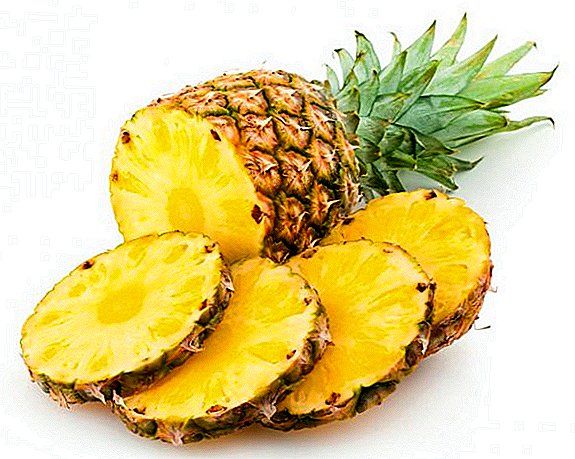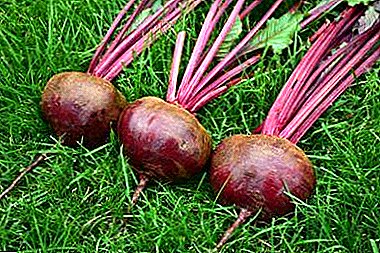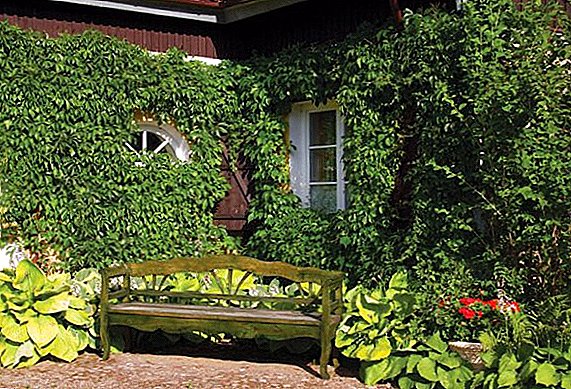 Landscape designers often use climbing plants to decorate the garden and various courtyards. They have high decorative characteristics and are able to significantly revive and decorate the local area.
Landscape designers often use climbing plants to decorate the garden and various courtyards. They have high decorative characteristics and are able to significantly revive and decorate the local area.
Did you know? Wild grapes, which are completely unpretentious in their care, are capable of forming dense thickets on all vertical surfaces. Clinging to them with airy suckers, he creates unique garden compositions.Curly flowers are used to create shady arches, decorating fences and gazebos. They are undemanding in care, they easily tolerate our winters, create a romantic atmosphere in the garden, significantly increasing its aesthetic appeal. This article presents the most popular species of perennials with photos and names.
Wild grapes
Wild grapes - non-capricious vine, related to perennials and actively used for gardening cottages.
If it comes to perennial gardening plants, it should be started from the wild or girlish grapes. This plant plays the first violin in landscaping gardens and local area. Particularly charming girlish grapes looks in the fall, when its leaves become saturated purple color. The plant has a phenomenal simplicity, and, by the way, it is easier to plant than to withdraw from the site. It does not need to create special conditions or fixation, but it is able to very quickly braid an impressive area, turning it into a solid green carpet.  Experienced landscape designers and even beginners with its help very quickly create the effect of exquisite antiquity on the site. Wild grapes dense lace braids the fence, protecting the local area from other people's curious glances. This fast-growing liana is also a perennialthat turns it into an ideal decoration for a garden, and the word “wild” in its name rather indicates unpretentiousness and high adaptation abilities of this representative grape, rather than its origin.
Experienced landscape designers and even beginners with its help very quickly create the effect of exquisite antiquity on the site. Wild grapes dense lace braids the fence, protecting the local area from other people's curious glances. This fast-growing liana is also a perennialthat turns it into an ideal decoration for a garden, and the word “wild” in its name rather indicates unpretentiousness and high adaptation abilities of this representative grape, rather than its origin.
This plant is a deciduous vine, covered with three-fingered or five-fingered leaves and small dark blue or black berries that are not recommended to be eaten. In the Far East, there are varieties that have white, orange and blue berries, which are also not used in cooking.
Important! Do not eat the fruits of girlish grapes, despite the fact that they look very similar to the berries of ordinary grapes. Eating a handful of its fruits will not cause a deadly poisoning, but here an upset stomach, and in some cases, you will be vomited.Gardeners appreciate wild grapes for their high ornamental characteristics, unpretentiousness and rapid growth.
Knyazhiki
Knyazhiki - The closest relatives of another popular climbing plant called clematis. These plants differ in the structure of flowers: the drooping bells of the princes are formed by small, barely noticeable petals and are bordered by larger sepals, while the clematis has no petals at all, and its flowers are colored in different colors by the sepals. Despite the fact that the name of the plant "princes" is translated from ancient Greek as "antennae", it is attached to vertical surfaces with the help of young leaves and petioles, since it has no antennae at all. In this regard, when growing plants as a support for him should use wire or rope nets.  Curly flowers for the garden, having the name of princes, will please gardeners with unpretentiousness, simple care, an unsightly disposition and generous flowering. Liana does not need to be removed for the winter from a support, cut off and protect from diseases. Another plus of growing these loaches is that they bloom early. And at that time, when clematis is only freed from winter shelter, princes are already covered with a dense carpet of green foliage. Alpine princes begin to bloom first, the Okhotsk variety takes their baton, and the Siberian marathon continues.
Curly flowers for the garden, having the name of princes, will please gardeners with unpretentiousness, simple care, an unsightly disposition and generous flowering. Liana does not need to be removed for the winter from a support, cut off and protect from diseases. Another plus of growing these loaches is that they bloom early. And at that time, when clematis is only freed from winter shelter, princes are already covered with a dense carpet of green foliage. Alpine princes begin to bloom first, the Okhotsk variety takes their baton, and the Siberian marathon continues.
Pedicel hydrangea
Petiole hydrangea is a unique type of hydrangea, which is radically different from its treelike and paniculate relatives. This climbing plant is often used for gardening fences, aided by the fact that it is considered fast-growing. The stem hydrangea in its structure is similar to a liana and does not have a solid trunk, but on the other hand, it has high decorative characteristics, due to which it is actively used in landscape design. It is unpretentious, but will require from the plant grower to ensure high-quality irrigation and provide it with a territory free from weeds for growth. Otherwise, the gardener risks getting unpleasant lace instead of dense green carpet with weed bushes sticking out in different places. 
Did you know? In comfortable conditions, the stalked hydrangea can reach the height of a four-story house. It is considered to be one of the longest plants used in landscape design.Thorny hydrangea belongs to frost-resistant species, but young plants still need to organize protection from freezing temperatures, since delicate shoots can suffer from frost. Liana is able to form a dense green carpet and braid objects of the most unusual forms.
Honeysuckle
Honeysuckle is a beautiful perennial climbing plant used for gardening gazebos, fences and arches. Liana has a delicate aroma, increasing in the evening hours, which significantly increases its decorative appeal. Honeysuckle can be the main decoration of any garden or house territory, and besides, it will effectively emphasize a unique style and will give a romantic charm to even the most dull part. Due to the fact that today there are many varieties of honeysuckle, blooming at different times, the plant breeder will be able to organize the wave flowering plants on the site. 
Important! Fruits of curly honeysuckle contain prussic acid, and therefore it is better to refrain from their use in food, but they are considered an excellent means of depriving. If there is a desire, then it is better to eat the fruits of edible honeysuckle, which is absolutely safe and is actively used in cooking for making jam, wine, jelly and stewed fruit.The most popular varieties of climbing honeysuckle:
- Honeysuckle Tatar - this vine, which with proper care can reach a length of 3 meters. It blooms in May and blooms until the end of June. Plant cultivar variety attracts with incredibly beautiful, white and pink flowers.
- Kaprifol reaches a length of more than 6 meters. Flowering lasts from June to July. During flowering produces creamy yellow flowers with a slight reddish tinge.
- Brown - quite unpretentious variety, shoots which can reach a length of up to 5 meters. It blooms from mid-June for three weeks, delighting the surrounding with luxurious carrot-red flowers.
- Telman forms whips reaching a length of not more than 5 meters. Liana blooms in mid-May. Blooms profusely for no more than two weeks. During this period, it is covered with charming golden-yellow flowers.
- Serotin is the latest flowering variety: the plant begins to bloom in August and blooms until early September. During this period fragrant cream flowers form on the liana. In comfortable conditions, the plant can reach up to 4 meters in length.
Clematis
Clematis - These are the most welcome guests in any garden. Bindweeds are often used to decorate the garden, especially since this perennial plant is completely unpretentious and has excellent frost resistance. Clematis captured the hearts of amateur and professional landscape designers with stunning star-shaped flowers framed by dark green foliage. Blooming clematis - a fascinating sight. And their wide color palette, ranging from white to maroon-brown, allows to realize the most extravagant and bold ideas.  The spread of lianas also contributes to the fact that it is independently fixed to the support by leaf petioles. This allows you to use as a support not only hard pergolas or tapestries, but also meshes that help to form flowering walls.
The spread of lianas also contributes to the fact that it is independently fixed to the support by leaf petioles. This allows you to use as a support not only hard pergolas or tapestries, but also meshes that help to form flowering walls.
With proper pruning, flowering vine can last long enough: from mid-June until the first frost. In order for clematis to develop well and delight in its generous flowering, it needs to be planted in well-lit places, in high-quality watering and regular feeding.
Actinidia
Actinidia - a perennial climbing plant, which is often used in landscape design to decorate a garden gazebo, gardening the fence and forming an arch, and it is the fact that it is perennial, combined with luxurious appearance, uncompromising character and rapid growth rates, brought him wide popularity. Liana comes from Southeast Asia. Especially popular are variegated varieties of actinidia - Kolomikta and Polygamy  Diversity of these varieties of actinidia does not appear immediately, but only two weeks before the appearance of flowers: first, the leaves turn white in the leaves, which then become crimson. This feature is characteristic of both female and male plants, but it appears only on hybrids obtained by crossing Argut and Purple varieties.
Diversity of these varieties of actinidia does not appear immediately, but only two weeks before the appearance of flowers: first, the leaves turn white in the leaves, which then become crimson. This feature is characteristic of both female and male plants, but it appears only on hybrids obtained by crossing Argut and Purple varieties.
Did you know? Actinidia is a dioecious plant, but sometimes fruits can be tied up if there are only female plants on the site. Presumably, 1% of all actinidia are monoecious plants that are especially valuable for breeding self-fruiting varieties.Actinidia is remarkable also in the fact that it is devoid of physiological fruit fall: all inflorescences that have been pollinated and turned into fruits will grow to full maturity.
Intensive pace of development - another trump card of this vine. If she does not interfere and create a comfortable environment, then for the season her shoots can grow by two meters. This feature of actinidia is often used by landscape designers in those places where it is necessary to carry out a quick gardening of the territory.
Tekoma
Vinyuna perennials who are called TEKOMAIn our climate zone it is very rarely grown in open ground. A native plant from South America and is widely distributed in Florida, Mexico, Argentina. Our company is mainly cultivated as a greenhouse or indoor plant. Tekoma is a member of the bignonium family. Today, about 16 species of this plant are known. In the natural environment, a com may reach a length of more than 6 meters.  Domestic plant growers grow capsis, which is dodging and standing erect, which are beautifully flowering deciduous vines. Different types of Tacoma have simple and complex leaves, consisting of 5 or 7 small lobes, with a jagged edge. Flowers vines have the shape of elongated bells, sometimes they resemble the funnel-shaped rims of yellow or orange hue, can reach more than 5 centimeters in diameter and gather in loose or racemose inflorescences. TEKOMA has a long and abundant flowering, which gives the impression that it is dotted with flowers. After flowering, the vine is covered with the fruits of the original form, externally similar to the beans.
Domestic plant growers grow capsis, which is dodging and standing erect, which are beautifully flowering deciduous vines. Different types of Tacoma have simple and complex leaves, consisting of 5 or 7 small lobes, with a jagged edge. Flowers vines have the shape of elongated bells, sometimes they resemble the funnel-shaped rims of yellow or orange hue, can reach more than 5 centimeters in diameter and gather in loose or racemose inflorescences. TEKOMA has a long and abundant flowering, which gives the impression that it is dotted with flowers. After flowering, the vine is covered with the fruits of the original form, externally similar to the beans.
Climbing Rose
Climbing rose is a favorite plant of landscape designers. Due to the fact that a lot of different varieties have been bred with her participation, it is possible to create real garden masterpieces.  Almost all modern varieties are remontant, which allows you to enjoy the flowering of this garden beauty almost all summer. This plant is not climbing in nature, its use in vertical gardening is due to its ability to produce incredibly long flowering shoots. The main disadvantage of climbing roses is that they cannot be fixed on the base independently, and therefore the plant needs periodic fixation of the lashes to the support.
Almost all modern varieties are remontant, which allows you to enjoy the flowering of this garden beauty almost all summer. This plant is not climbing in nature, its use in vertical gardening is due to its ability to produce incredibly long flowering shoots. The main disadvantage of climbing roses is that they cannot be fixed on the base independently, and therefore the plant needs periodic fixation of the lashes to the support.
Wisteria
Despite the fact that initially wisteria did not differ in resistance to low temperatures, thanks to the hard work of breeders, modern varieties are able to withstand quite severe frosts. The kind of blooming wisteria will surely leave even the most inveterate skeptic in the soul an indelible mark. Thermophilic wisteria delights residents of the Caucasus, Crimea and Transcarpathia with abundant and long flowering, while residents of the northern regions can see its flowers for quite a limited time. In the northern latitudes, the plant grows weaker and shallower, and besides, it needs winter shelter.  Wisteria, or wisteria, is a representative of tree-like high subtropical plants belonging to the legume family. Wisteria has large, pinnate leaves and, during flowering, is covered with a waterfall of white or light purple inflorescences, reaching a length of up to 30 centimeters. The first flowers on the liana appear in spring, and individual inflorescences can remain on the plant until the end of summer. Wisteria is very often used in landscape design for landscaping vertical structures.
Wisteria, or wisteria, is a representative of tree-like high subtropical plants belonging to the legume family. Wisteria has large, pinnate leaves and, during flowering, is covered with a waterfall of white or light purple inflorescences, reaching a length of up to 30 centimeters. The first flowers on the liana appear in spring, and individual inflorescences can remain on the plant until the end of summer. Wisteria is very often used in landscape design for landscaping vertical structures.
Ivy
Ivy - This is an evergreen climbing plant, which is capable of climbing without any help vertically upwards for fairly long distances. This unusual ability of ivy is due to the fact that it has adventitious root-suckers, capable of catching any, even slightly rough surface and reliably fix the shoots in an upright position.  Ivy flowers have low decorative qualities. If there is no support for this creeper nearby, it will cover the soil on your garden plot with a dense carpet. The plant has emerald green dense shiny leathery leaves, creating the illusion of impenetrability.
Ivy flowers have low decorative qualities. If there is no support for this creeper nearby, it will cover the soil on your garden plot with a dense carpet. The plant has emerald green dense shiny leathery leaves, creating the illusion of impenetrability.
Hop
Hop - This is another plant that is often used for decorative purposes. Liana can grow on the site for more than 20 years. Hops belong to the family of hemp, but it differs from the latter by the presence of a long climbing stem that can reach up to 7 meters. The stem of the hops religiously climbs up and twists the support clockwise. Its tetrahedral stem is hollow inside, and the outside is covered with tiny curved spines, allowing it to easily climb on any support. The plant has rough to the touch leaves, which are located on long petioles and covered with yellow glands.  Hop begins to bloom in the second half of summer, its inflorescences from female plants are collected in charming loose cones, and in male plants - in panicles. In early summer, the vine is covered with fruits. Hops unpretentious, but prefers to grow on well-moistened soils.
Hop begins to bloom in the second half of summer, its inflorescences from female plants are collected in charming loose cones, and in male plants - in panicles. In early summer, the vine is covered with fruits. Hops unpretentious, but prefers to grow on well-moistened soils.
Lemongrass Chinese
Lemongrass Chinese - This is a light and elegant vine that can reach up to 15 meters in length. In comfortable conditions, the plant for the season is able to please with a three-meter annual increase. Liana has high decorative characteristics and a huge therapeutic potential. On the support Chinese schisandra is fixed by means of shoots. Like the hops, he twists the support only clockwise. The plant prefers to climb up the wooden or plastic supports. In order to prevent freezing of the shoots of the vine, it is better to refuse to use metal structures as a support, since it is simply impossible to remove the vine from them. Due to the impressive length of the shoots, Chinese lemongrass is very often used for gardening arbors, terraces and houses.  Through the proper use of landscaping for perennial climbers, you can create the most real landscape masterpieces. The main thing is to turn on the fantasy and choose the right vine.
Through the proper use of landscaping for perennial climbers, you can create the most real landscape masterpieces. The main thing is to turn on the fantasy and choose the right vine.


